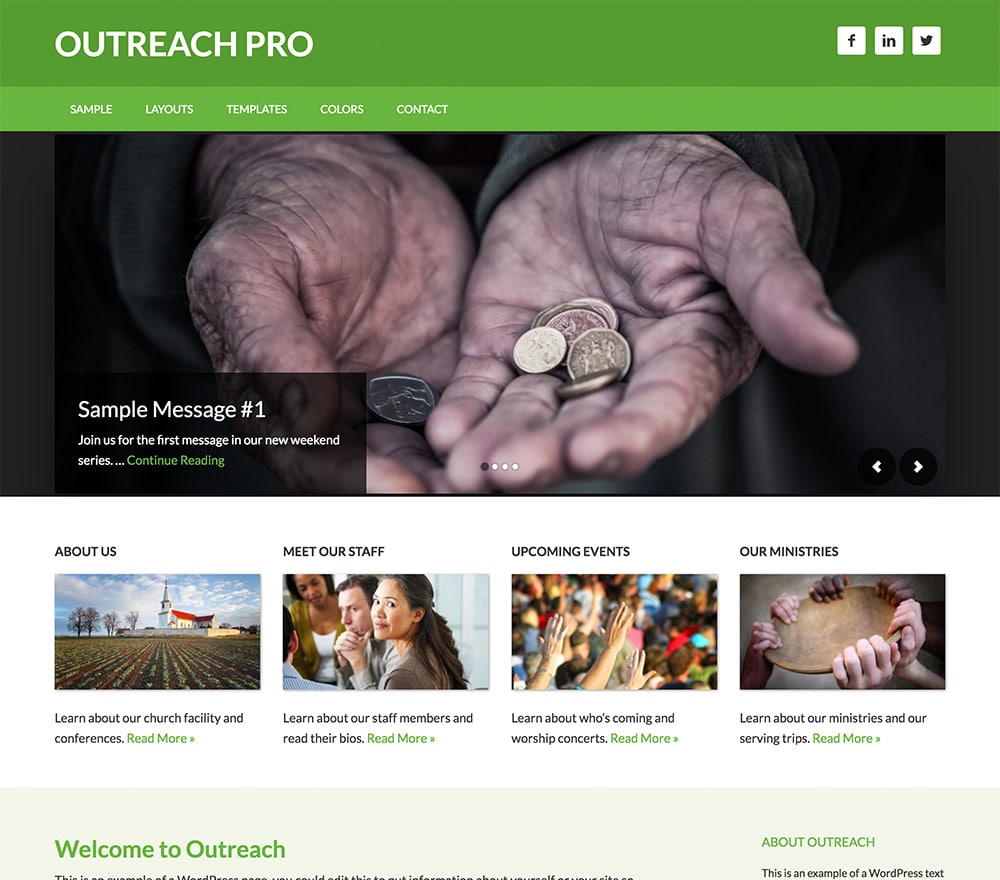When you are planning a new website for your nonprofit, you will need to decide on the platform that powers the website. Squarespace and WordPress are two popular options. Both have a range of features suitable for a nonprofit website.
I build nonprofit websites with both options. In general, I recommend WordPress for the long-term, but Squarespace is excellent for a small nonprofit website. I also have nonprofit clients that are running their sites successfully with Squarespace and have done so for years.
As a nonprofit, you have the task of finding a system that will provide all the features you need while fitting into your budget. In this post we take a look at these two popular web platforms, and note some advantages and drawbacks of each.
Following the summary, you’ll find a more in-depth comparison of the two. If you just want the bottom line, you can skip to the end. Even if you are not running a nonprofit website, you may find the feature comparison useful.
What are WordPress and Squarespace?
Squarespace and WordPress are also known as content management systems (CMS). A CMS is just the software you use to edit the content on your website. A CMS will allow you to do things like accept donations and collect contact information.
WordPress is an open-source CMS that you run and manage on your own web hosting account. A web designer or developer will create a custom theme or install an existing theme for you. The theme controls the design of the website. You can install WordPress plugins that add functionality to your website.
Squarespace is an all-in-one platform that combines web hosting, design, and content management into one system. A designer will modify an existing template, or create a custom one using the developer platform. Most of the website functionality is already built into Squarespace, and you can use some third party solutions to fill in any gaps.
Why should I use WordPress?
WordPress can be a great choice for a nonprofit website. It’s widely supported, stable, and adaptable. The availability of high-quality themes can help provide a solid design foundation for the website, and completely custom themes can be built as well. Plugins for accepting donations, creating forms and event calendars bring additional functionality to the website.
Example WordPress Nonprofit Themes
WordPress also makes content management straightforward. It works well in a multi-author environment where more than one person is contributing to the website. Content can be version controlled, granting authors the ability to revert changes. The content editor is easy to use, and anyone familiar with word processing software will be able to use it without trouble.
WordPress Pros
- Flexible and customizable
- Open-source
- Portable (you can move your site to a different host)
- Widely supported
- Many third party themes and plugins available
- Content version control
Why should I choose Squarespace?
The Squarespace platform can also be a good choice for a nonprofit website. The available templates are well designed, helping you create a consistent experience across your website. You can customize the designs further with the Squarespace tools, or hire a web developer with knowledge of CSS, the web language used to style websites.
Example Squarespace Templates for Nonprofits
With other platforms such as WordPress, a web developer may spend more time modifying source code to create a custom design for your website. In general, Squarespace allows a web designer or developer to build a site faster, saving you money and getting your project live sooner.
Squarespace Pros
- Easy and quick to get started
- High-quality templates
- Potentially lower initial cost
- Less complicated than WordPress
- All-in-one solution
What are the potential drawbacks to WordPress?
A common objection to WordPress relates to security. Because WordPress is a widely used platform, it can be a target for those that want to cause trouble. But much of the security concerns with WordPress can be accounted for with correct setup of the software and theme, careful use of plugins, and a secure hosting environment.
It is recommend to use WordPress-specific hosting such as Kinsta or Pantheon. (See my notes about WordPress hosting.) Other considerations with WordPress would be the need for ongoing software updates and the cost of any commercial plugin licenses.
WordPress Cons
- Easier to create potential security problems
- May require more expensive hosting
- More complex to set up and modify
- More expensive if you hire a developer
What are the potential issues with Squarespace?
Squarespace does many things very well. However, you may find an occasion where you run into limitations of the platform. It doesn’t do everything, and it is more difficult to get around limitations than WordPress.
There is no content versioning, which means it’s harder to see what has changed and more difficult to undo accidental changes. The media management tool is limited—you may find yourself uploading multiple copies of the same image for use on different pages. Sometimes the page editor can be a bit quirky.
Squarespace Cons
- Less flexible in the long run
- Harder to fine tune your site performance
- More difficult to optimize for search engines
- Not set up for content versioning or multi-author environment
- Limited backup options and hard to undo changes
WordPress and Squarespace Feature Comparison
Now that we know the basics, let’s do a more in depth comparison of the two rival content management systems. Note that throughout this guide, I am referring to the self-hosted version of WordPress, not wordpress.com.
Website Design
Both platforms offer a number of design options for your site. WordPress excels in the variety of design options available, while Squarespace gives you a set of excellent and consistent templates. Both allow you to customize your website design to suit your brand or project.
The design of your WordPress website is driven by the theme you install. It’s up to you or a designer to customize the theme to fit your project. As the site editing and design customization experience will vary depending on the chosen theme, it’s important to select a professional theme from the start.
Some WordPress themes will use a page builder, and others will use the new block-based page editor. You may want to try out a handful of themes, or have your designer recommend a good theme.
With Squarespace, you select a template on which to base your site design. All of the Squarespace templates have been professionally designed, and offer an excellent starting point for your website.
Using the customization options within Squarespace, you can easily change the fonts, color, and page layout of your site. You’ll have access to most areas of the site, though not total design freedom as you do with WordPress.
WordPress or Squarespace for website design: who wins?
I would have to choose WordPress due to the large number of open source and commercial themes available. You can customize just about every aspect of your site and get exactly the end result you want. Of course with a large number of options comes complexity, and the task of finding or building a high quality theme.
However, if you are looking to simplify your approach, and want a well-designed starting point, Squarespace is a good choice. The designs built into the platform should serve your needs nicely. You can always customize the template further using the options within Squarespace, or with a little custom CSS.
And both systems allow you to change the design later on by choosing a new theme or template.
Ease of Use
Both platforms are easy to use, but one more so than the other. WordPress has evolved as a CMS over the years. Originally starting as a blogging platform, WordPress now powers marketing, e-commerce, portfolios, and other types of websites. It still excels at managing text content and other media.
However, the user interface can be confusing to a new user due to the large number of options and interface screens. The editing experience depends on the active theme and plugins, and it can vary between websites. Plugin configuration and upkeep can be a chore.
With Squarespace, website editing is consistent and intuitive. By giving up a little control, you gain a smoother experience overall. Since everything is built into the platform, you don’t need to worry about software or server maintenance.
WordPress, Squarespace, and ease of use: who wins?
Although some will likely argue this point, Squarespace is the clear winner for ease of use. Its focused design has the edge for consistency and a smooth user experience.
WordPress is easy to use once you gain some experience with it. If you are comfortable with web-based software and appreciate the ability to configure things to your liking, you may prefer it.
I’ll also note that WordPress is far more keyboard accessible. If you navigate with the keyboard, or like to give your hands a break from the mouse, WordPress is designed with accessibility in mind.
Search Engine Optimization (SEO)
You may not be thinking about search engine optimization if you are just starting out. However, this will become important to you as your site grows. Ideally, you’d start your SEO planning now when your site is new.
Both Squarespace and WordPress provide options for managing aspects of your website’s SEO. You can easily set the page title, slug, meta description, and image alt text. This is built into the Squarespace platform. With WordPress you typically use a plugin for some SEO settings such as Yoast SEO.
With plugins, WordPress has some advanced SEO features for power users. Using MonsterInsights for example, you can analyze your page headings for possible optimizations. You can add plugins from SEMrush for writing analysis. Google offers their Site Kit plugin for integrations with Google Analytics, Search Console, and other Google products.
Technical SEO and Performance Optimization
One important aspect of website SEO is performance optimization. Basically, this means setting up your website so that it loads as fast as possible and fixing any technical issues. With WordPress, you have access to the underlying website source code, so it’s possible to customize everything. You can use caching and optimization plugins as needed to speed things up. If your web hosting is slow, you can move to a higher-end WordPress host.
Since Squarespace is an all-in-one hosted platform, any optimizations are done for you. You do not have the same level of control that you do with WordPress. This may not be a big consideration to you if you are just starting out, but it may be important to you down the road.
WordPress or Squarespace for SEO: who wins?
WordPress has an edge in the SEO category due to the ability to fine tune your hosting environment and website source code. Squarespace provides some good and essential SEO settings, but you can go further with WordPress making it a good long-term choice.
Content and Image Management
As the name suggests, a content management system is supposed to help you manage your website content. Along with adding new content, it should allow you to easily browse your existing content, review past revisions of content, and make backups.
A CMS needs to have a way of controlling user access and permissions. And the content should be separated from the design as much as possible.
Squarespace covers some of these bases, but not all.
- With Squarespace, there is no way to review content revisions. The best you can do is make a copy of a page before you change it.
- While you can apply a new template to a site, the design is a little more integrated with the content editor.
- Both WordPress and Squarespace allow you to control user access, and have multiple permission levels.
- You can’t create automatic backups with Squarespace, but you can export content, and duplicate a site.
- The Squarespace image management tool is only available when uploading media, and is difficult to browse.
WordPress excels at content management.
- Posts and pages are versioned by default. You can keep track of text changes over time and easily revert to an earlier version.
- User access and permissions are more granular. There are more default user permission levels than Squarespace.
- You will need additional plugins for site backups, but there are some popular ones that will handle the job. Your hosting provider may have integrated backups as well.
- And the content is generally more separated from the design, but that will depend greatly on the theme. If you use a page builder for instance, you may be in for a shock if you try and switch themes.
- The WordPress media manager is easily accessible and provides full details on the images and media uploaded to the site.
WordPress or Squarespace for content management: who wins?
WordPress is designed with content management in mind. Content revisions, a media manager, user permissions, and separation of design and content are all built-in. Websites are easily backed up with plugins, or backup systems at the hosting level.
Squarespace was initially designed as a visual site editor. It now has features you would expect to find in website management software such as user permissions, and a media manager. Some features are lacking such as content revisions and full site backups.
Overall, WordPress beats Squarespace for content management, but both are excellent platforms and excel in different areas.
E-commerce and Donations
An important part of a nonprofit website is the ability to accept donations. Squarespace makes this easy with built-in functionality. You’ll just need to connect your payment processor such as Stripe or Square.
WordPress requires plugins to assist in accepting donations via your website. A popular one for nonprofits is the GiveWP plugin and add-ons. It’s easy to use, but I like the ability to set it up within Squarespace without any additional software.
E-commerce is also easy to set up and manage from within Squarespace. If you have a physical storefront, you can accept payments with the Squarespace point of sale system, and synchronize your Square account.
The most popular e-commerce solution in WordPress is WooCommerce. Having managed some WooCommerce sites before, I can say that it is not as straightforward to set up as commerce within Squarespace. There are many more interface screens, and managing individual items is tedious.
WordPress or Squarespace for e-commerce: who wins?
Squarespace is by far much easier to set up and manage than WordPress for accepting donations and running an e-commerce website. If you only need to accept donations, or have a simple store, Squarespace will work well. If you need to integrate with a special payment gateway or have more complex needs, WordPress is the way to go.
So which one should I choose?
Ultimately, that decision will be driven by the specific needs of your project. Squarespace will get you up and running quickly, and likely for a lower cost. WordPress will give you more flexibility in the long run. If you are just starting out building a website for a nonprofit, Squarespace is a great choice to get online with a lower investment.
Some things to keep in mind when planning a website design project are:
- The initial design cost
- Ongoing cost of hosting and maintenance
- Recurring software licensing fees
- Whether the system will meet your needs
- And if the platform is flexible enough for changes and enhancements.
Whatever you choose, there are ways to migrate at least some data from one to the other so you are not locked into a system. You can always make a change in the future. Keep in mind any platform migration project will be comparable to a new website project in cost and scope.
If you need help deciding, or would rather hire someone to build your website, don’t hesitate to get in touch.









